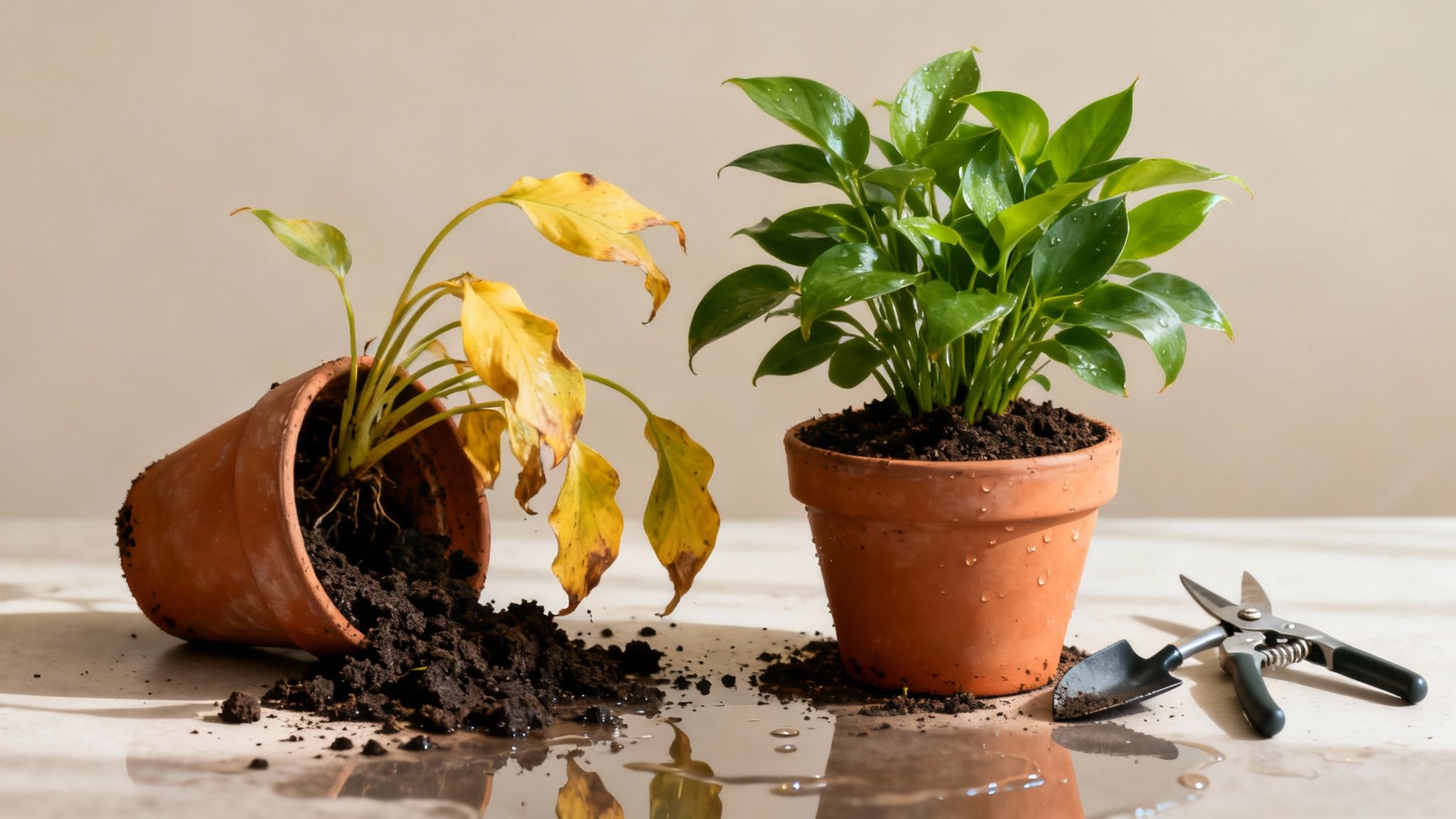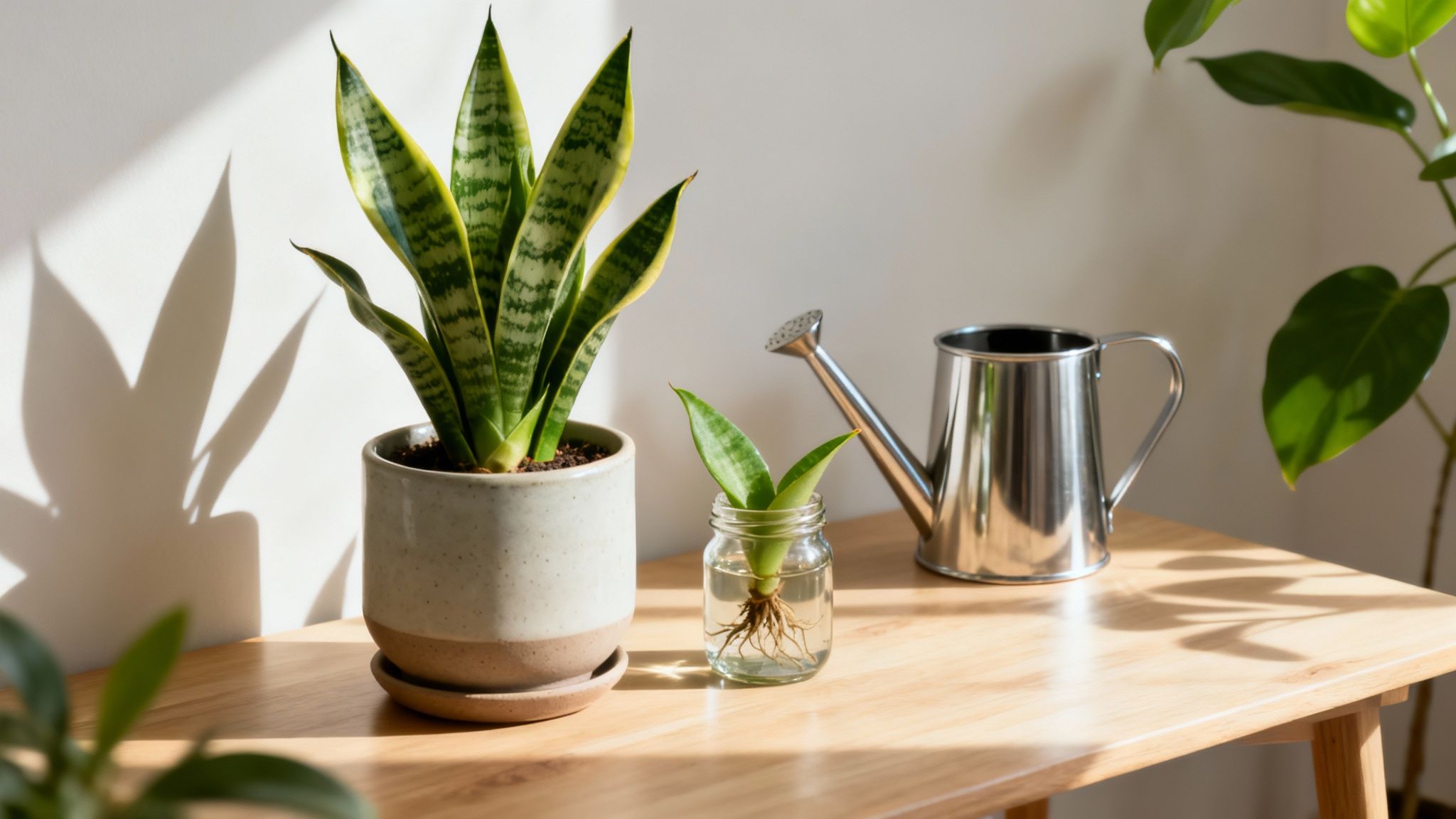When the air gets that crisp, cool edge, it’s tempting to hang up your trowel and call it a season. But that’s one of the biggest mistakes you can make as a gardener. Fall isn't the end of the gardening year; it’s the secret start to the next one. What you do now is your golden ticket to a healthier, more explosive spring garden. This guide will walk you through turning your garden into a powerhouse of potential, from building incredible soil to giving your favorite plants the protection they need to thrive.
Why Fall Is Your Garden's Most Important Season
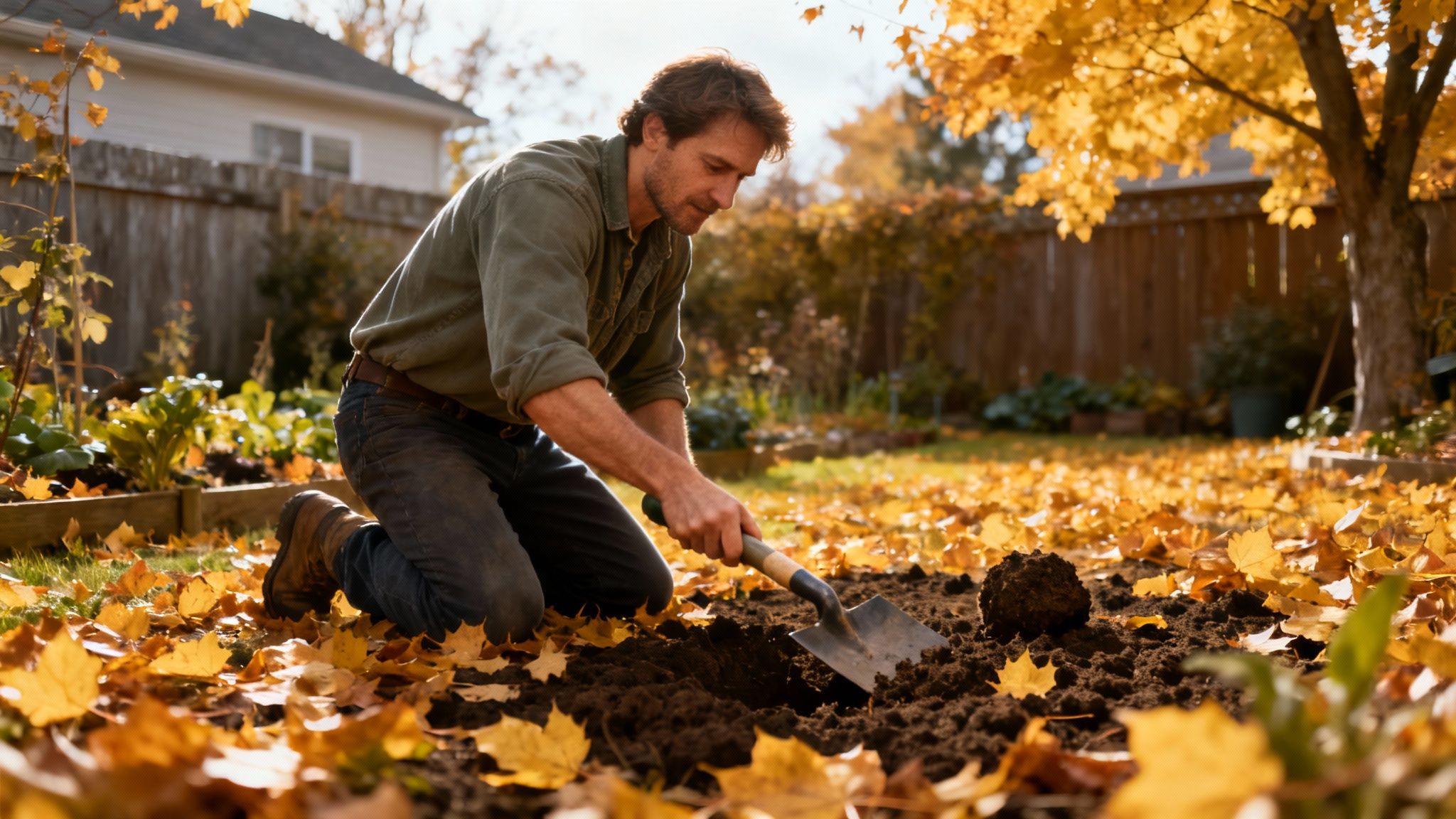
Think of your fall garden as the prep kitchen for a five-star meal. All the chopping, measuring, and marinating happens now so that when it’s time to cook, everything comes together perfectly. Summer is about enjoying the harvest, but autumn? Autumn is for smart, strategic moves that pay off big time.
Setting the Stage for Spring
The cool air and gentle rains of fall create the perfect conditions for roots to get established without the brutal stress of summer heat. This is the ideal window for planting spring-flowering bulbs, dividing tired perennials, and even sowing certain veggies to give them a massive head start.
Soil Temperature: The ground is still warm enough to encourage root growth, but the cool air means less water evaporates, so plants aren't as stressed.
Pest and Disease Prevention: A thorough cleanup now gets rid of the hiding spots where pests and fungal spores love to spend the winter. Fewer hiding spots now means far fewer problems next year.
Nutrient Cycling: When you add amendments like compost in the fall, they have all winter to break down. By spring, a buffet of nutrients is ready and waiting for your plants' roots.
It can feel overwhelming trying to figure out which plant needs what. That's where tools like Tendra’s AI plant identification and Smart Care Reminders can be a game-changer, taking the guesswork out of giving each plant exactly what it needs to flourish.
A little dedicated effort in your garden in fall builds a resilient, beautiful landscape that lasts the entire year. It’s an investment that pays you back in spades with bigger blooms, better harvests, and healthier plants.
This season is your chance to fix any issues from the past year and lay a solid foundation for the future. We're about to dive into why working your soil now is so effective, the simple magic of planting for future flowers, and how a smart cleanup can save you a world of headaches down the road.
Get ready to see your fall garden not as an ending, but as the powerful beginning it truly is.
Building a Resilient Foundation in Your Soil
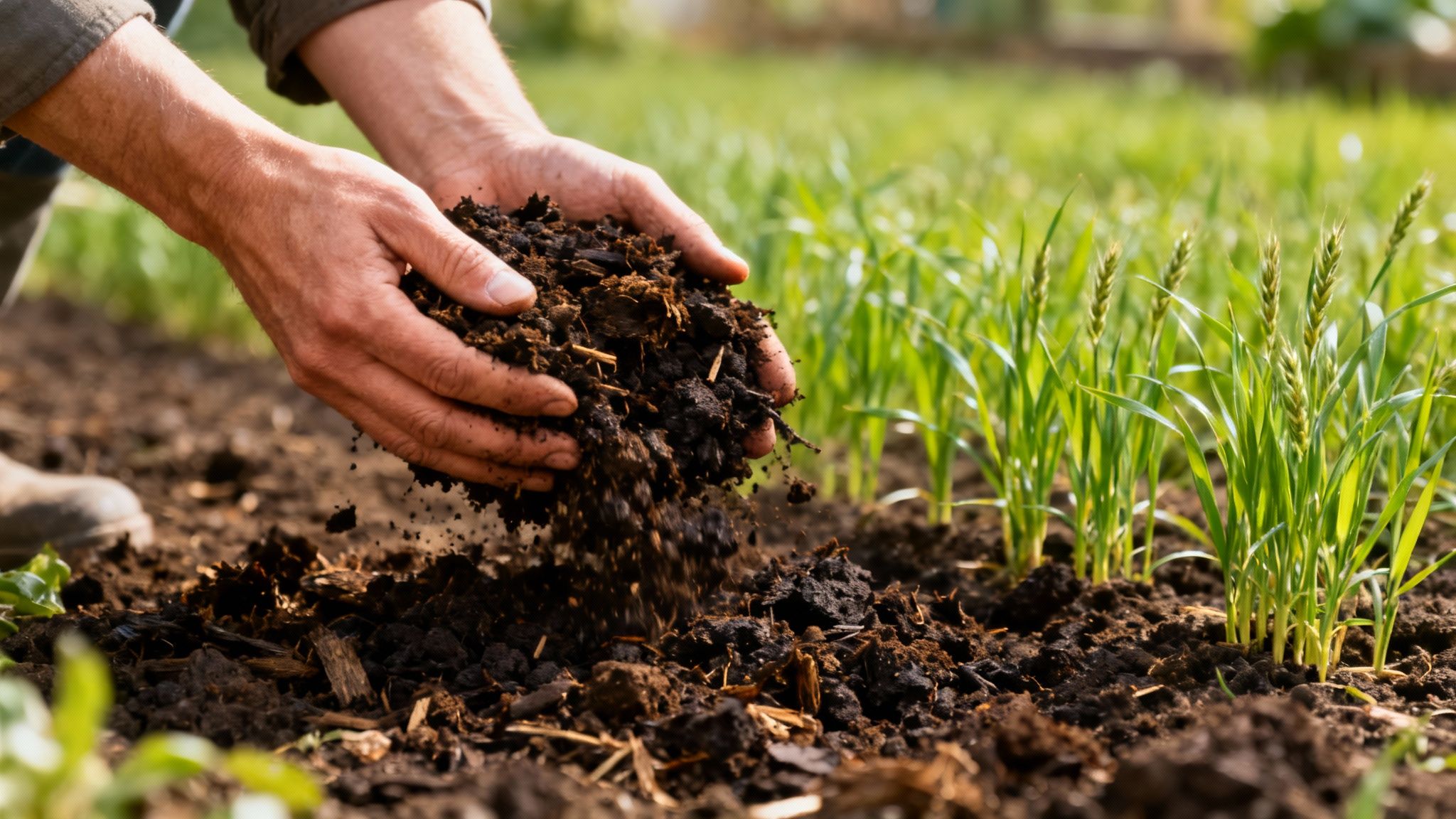
A truly great garden starts from the ground up, and fall is the perfect time to get your hands dirty and invest in your soil. Think about it—the summer's growing season was intense, and your soil is likely tired, compacted, and running on empty. But right now, the earth is still warm enough for all that good microbial life to thrive, yet cool enough for you to work without breaking a sweat.
Getting your soil health right is the single most important move you can make for a knockout garden next year.
Assess and Clear Your Garden Beds
First things first: give your garden a clean slate. Gently pull out all the spent annuals, old vegetable plants, and any stubborn weeds that have popped up. This isn't just about being tidy; it's a critical strategy for managing pests and diseases.
If you leave dead plant material in the garden, you're essentially rolling out the welcome mat for pests like squash bugs and diseases like powdery mildew to spend the winter. A thorough cleanup now means far fewer headaches in the spring.
The Power of Organic Matter
With your beds cleared, it’s time to give back. Blanketing the soil with a generous layer of organic matter is non-negotiable. This acts like a slow-release battery, charging your soil with nutrients all winter long.
Compost and aged manure are two go-to choices.
Compost: This is the undisputed champion. Made from decomposed kitchen scraps and yard waste, it does it all—improves soil structure, helps it hold water, and feeds your future plants a perfectly balanced diet.
Aged Manure: If you need a serious nutrient boost, aged manure is fantastic. It's much richer in nitrogen. Just make sure it’s well-rotted; fresh manure is too "hot" and will scorch plant roots.
Aim to spread a 2-3 inch (5-7.5 cm) layer of your chosen amendment across the beds. You can gently work it into the top few inches, or you can just leave it on top. Earthworms will thank you by doing all the hard work for you.
Adding organic matter in the fall is like making a long-term investment in your garden’s health. The nutrients have months to break down, creating a perfectly fertile and welcoming bed for spring planting.
Plant a Living Blanket with Cover Crops
If you want to take your soil-building game to the next level, try cover crops. These are fast-growing plants—sometimes called "green manure"—that you sow in the fall specifically to protect and enrich your soil over the winter. They are a cornerstone of sustainable gardening.
Cover crops stop winter wind and rain from washing your precious topsoil away, suppress weeds, and add a huge amount of valuable organic material back into the earth when you turn them over in the spring.
Top Cover Crop Choices
Crimson Clover (Trifolium incarnatum): This is an amazing nitrogen-fixer. It literally pulls nitrogen from the air and stores it in its roots, making it available for next season’s hungry plants.
Winter Rye (Secale cereale): Its deep, fibrous root system is a beast when it comes to breaking up heavy, compacted soil and improving its structure.
Hairy Vetch (Vicia villosa): Another nitrogen-fixing powerhouse that creates an excellent, weed-suppressing ground cover.
Choosing the right cover crop depends on your local climate and what your soil needs. If you're not sure where to start, leaning on your community is a game-changer. For instance, Tendra’s Twin Plant Mates feature can connect you with local gardeners who know your regional soil inside and out. It's part of a growing movement—in fact, a surprising 55% of US households now participate in gardening activities. You can read more about current gardening trends to see what's on the horizon.
Planting Now for a Spectacular Spring
It might feel counterintuitive to garden for a season that's still months away, but some of the most satisfying work you can do in the fall is for the future. Fall planting is the secret to a jaw-dropping spring display—an investment in beauty that pays off with a burst of color right when you’re craving it most.
Think of this as your guide to tucking the promise of spring into your garden, from brilliant bulbs to delicious early harvests.
The Magic of Spring-Flowering Bulbs
There’s nothing like the first glimpse of a crocus or daffodil pushing its way through the cold, tired ground. Planting spring-flowering bulbs like tulips (Tulipa), daffodils (Narcissus), and crocuses (Crocus) is a classic fall ritual for a reason. It’s how you guarantee your garden wakes up with a shout of life.
These bulbs need a period of cold dormancy to kickstart their blooming cycle, which is why getting them in the ground now is non-negotiable.
Timing is Key: Aim to get your bulbs planted about six weeks before the ground freezes solid in your area. This gives them just enough time to establish a healthy root system.
Location, Location, Location: Most bulbs demand well-draining soil and a decent amount of sun. Soggy soil is their worst enemy and will cause them to rot over the winter.
Choosing the right varieties for your climate is critical. Not sure what will thrive where you live? Our gardener's guide to the USDA planting zone chart can help you zero in on the perfect picks.
The infographic below gives you a quick visual on planting depth and spacing for three of the most popular spring bulbs.
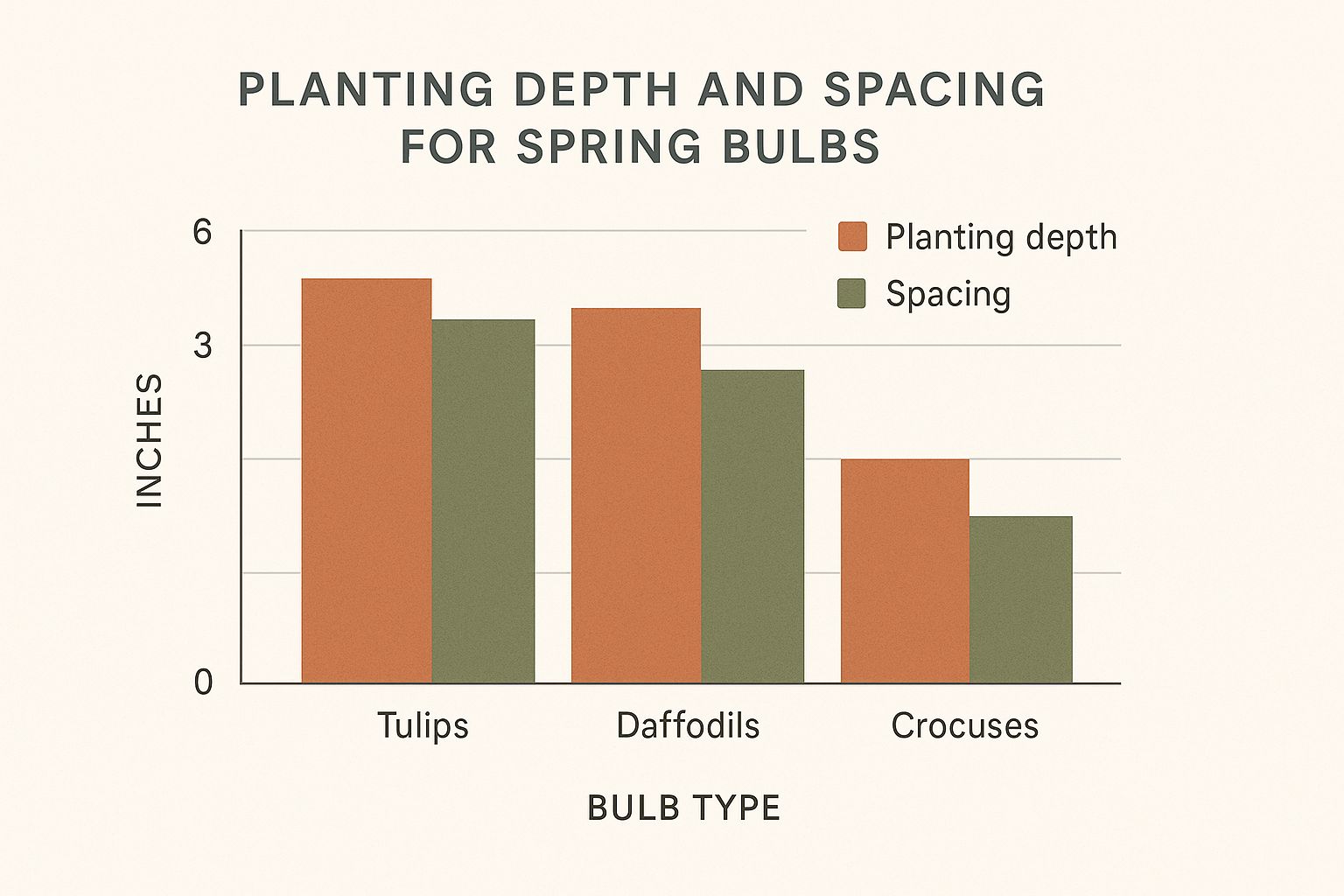
A good rule of thumb is to plant a bulb about three times as deep as it is tall. This provides plenty of insulation from any wild temperature swings.
To make things even easier, here’s a quick reference table for some spring favorites.
Fall Planting Guide for Spring Blooms
A quick reference for planting popular fall bulbs and perennials, including ideal planting times, depths, and spacing for a vibrant spring garden.
Plant Type | Ideal Planting Time | Planting Depth | Spacing | Sunlight Needs |
|---|---|---|---|---|
Tulips | Mid-fall | 6-8 inches (15-20 cm) | 4-6 inches (10-15 cm) | Full Sun |
Daffodils | Early to mid-fall | 6-8 inches (15-20 cm) | 6 inches (15 cm) | Full to Part Sun |
Crocuses | Early fall | 3-4 inches (7.5-10 cm) | 3-4 inches (7.5-10 cm) | Full to Part Sun |
Hyacinths | Mid-fall | 6 inches (15 cm) | 6 inches (15 cm) | Full to Part Sun |
Alliums | Mid to late fall | 4-8 inches (10-20 cm) | 6-8 inches (15-20 cm) | Full Sun |
This table should get you started, but always double-check the specific requirements for the varieties you choose.
Get Creative With Bulb Layering
For a truly show-stopping display that keeps on giving, you have to try a technique called lasagna planting. It’s a brilliant method where you layer different types of bulbs in a single hole or container to create continuous waves of color from early to late spring. It’s like planting a living bouquet that blooms in stages.
Here’s a simple recipe for a lasagna-planted container:
Bottom Layer (Deepest): Start with large, late-blooming bulbs like daffodils or tulips. Plant them about 8 inches (20 cm) deep.
Middle Layer: Add a layer of soil, then plant mid-season bloomers like hyacinths (Hyacinthus) about 5 inches (13 cm) deep.
Top Layer (Shallowest): Finish with a final layer of soil and plant small, early bloomers like crocuses or snowdrops (Galanthus) just 3 inches (7.5 cm) deep.
With this setup, as one type of flower begins to fade, another is just starting to emerge. The result is a dynamic, long-lasting floral show that makes you look like a gardening genius.
Divide and Conquer Your Perennials
Is your favorite hosta (Hosta) or daylily (Hemerocallis) starting to look a little crowded? Maybe it’s not putting on the show it used to. Fall is the perfect time to divide and transplant those overgrown perennials.
The cooler, wetter weather of autumn helps minimize transplant shock, letting the plants focus their energy on establishing strong new roots before winter arrives. Just gently dig up the entire clump, carefully separate it into smaller sections with a sharp spade or garden knife, and find them new homes. It’s a completely free and easy way to multiply your favorite plants.
Plant an Early Food Harvest
Your fall gardening efforts aren't just for flowers. You can also get a fantastic head start on next year's edible garden.
Planting garlic cloves now is the secret to a huge, robust harvest next summer. On top of that, many cold-hardy greens actually thrive in the crisp autumn air. Sowing seeds for spinach, kale, and certain types of lettuce can keep you in fresh salads well into the cooler months. These plants often develop a sweeter, richer flavor after a light frost.
The Smart Way to Prune and Clean Your Garden

A good fall cleanup is one of the best things you can do to guarantee a healthier garden next spring. Think of it less like tidying up and more like a strategic strike against pests and diseases. You're actively breaking the life cycles of problems that would otherwise come roaring back when things warm up.
But it’s a balancing act. The goal is to make smart, selective choices—removing real threats while leaving behind valuable resources for your local wildlife. Get this right, and you’re setting the stage for a resilient, beautiful landscape.
Identifying and Removing Diseased Material
First, play detective. Go on a hunt for any lingering signs of disease from this past season. We're talking about things like the ghostly white of powdery mildew on squash leaves, ugly black spot on your roses (Rosa), or the dreaded blight on tomato plants.
Leaving this material in your garden over winter is like rolling out the welcome mat for these pathogens. They’ll happily overwinter in the soil and on leftover plant bits, ready for round two next year.
Action Step: Carefully cut back and remove all plant parts that look diseased.
Crucial Tip: Whatever you do, do not throw this material into your home compost pile. Most home compost systems don't get hot enough to kill off pathogens. Bag it up for your municipal green waste or burn it if you're allowed to in your area.
Every now and then, you'll find something you just can't place. Is it a fungus? A pest problem? This is where a tool like Tendra’s AI disease diagnosis can be a real game-changer. You just snap a picture, and the app helps you figure out what you're dealing with, so you can act with confidence. To get a better handle on common problems, you can learn more about identifying plant diseases and saving your garden.
The Art of Selective Pruning
Knowing what to snip in the fall—and what to leave alone—is absolutely critical. One wrong cut can mean no flowers next year.
What to Prune Now
Summer-Flowering Woody Perennials: Plants like lavender (Lavandula) and salvia (Salvia nemorosa) appreciate a light trim to remove the spent flower stalks. This also helps them keep a nice, tidy shape.
Damaged or Dead Branches: Take a close look at your trees and shrubs. Any branches that are dead, broken, or rubbing against each other should go. Removing them now prevents them from becoming a hazard in a winter ice or snow storm.
Overgrown Perennials: After the first hard frost zaps them, you can cut back herbaceous perennials like peonies (Paeonia) and bee balm (Monarda) to about 2-4 inches (5-10 cm) above the ground.
What to Leave Alone
The golden rule here is simple: if it blooms in the spring, don't prune it in the fall. Plants such as lilacs (Syringa vulgaris), forsythia (Forsythia), and rhododendrons (Rhododendron) have already formed the flower buds for next season. If you prune them now, you’re literally cutting off next spring's show. Wait until right after they finish flowering next year to shape them up.
A Balanced Approach for Wildlife
A perfectly sterile, manicured winter garden isn't a healthy one. This is a big shift in how many of us think about gardening, moving toward more sustainable and ecosystem-friendly practices. Our yards can be small but mighty habitats.
A garden that offers winter food and shelter for wildlife is a living ecosystem. By leaving certain elements behind, you create a more dynamic and resilient environment that benefits birds, beneficial insects, and your plants.
Think about leaving these elements in place to create a healthier habitat:
Seed Heads: The seed heads on plants like coneflowers (Echinacea) and black-eyed Susans (Rudbeckia) are a vital, high-energy buffet for winter birds like finches and juncos.
Ornamental Grasses: Those tall, flowing grasses do more than just add beauty and movement to the winter landscape. They also provide crucial shelter for beneficial insects to ride out the cold.
Hollow Stems: The hollow stems of some perennials can become overwintering sites for native bees—the unsung heroes of pollination in your garden.
By adopting this balanced approach, you do more than just clean up. You prevent disease while creating a winter sanctuary, making sure your garden is not just tidy, but truly alive.
Protecting Your Plants from Winter's Bite
As the last vibrant colors of fall fade, our focus as gardeners needs to shift from active growth to strategic protection. When the first freezing temperatures arrive, it's our cue to tuck the garden in for its long winter nap.
This final act of the season is crucial. Proper winterization ensures all your hard work pays off, rewarding you with healthy, vigorous plants ready to burst back to life in the spring. Think of it like putting a warm blanket over your garden beds—you're not trying to stop winter, but you are shielding your plants from its harshest effects, like brutal winds and damaging freeze-thaw cycles that can heave roots right out of the ground.
Insulate Roots with a Layer of Mulch
One of the simplest and most effective things you can do is apply a protective layer of mulch. This is your garden's winter coat. It insulates the soil, keeping the temperature far more stable and preventing the repeated freezing and thawing that can tear delicate root structures apart.
A good layer of mulch also helps the soil hang onto moisture and suppresses any ambitious winter weeds that might try to pop up during a warm spell. You're basically creating a stable, protected environment where the roots can rest until spring.
Spreading a 2-3 inch (5-7.5 cm) layer of organic mulch after the first hard frost is the single best way to protect your perennial roots. It moderates soil temperature and prevents the ground from heaving during freeze-thaw cycles.
So, what should you use for this protective layer? Luckily, nature often provides the perfect materials right in your own yard.
Shredded Leaves: Don't bag up all those fallen leaves! Run them over with a lawnmower to shred them. This creates a fantastic, nutrient-rich mulch that will slowly decompose and feed your soil.
Pine Straw: Lightweight and slow to break down, pine straw (pine needles) makes an airy, insulating layer that won't compact and smother plant crowns.
Wood Chips or Bark: These are excellent choices for spreading around shrubs and trees, providing long-lasting insulation and protection.
The key is timing. Apply your mulch after the ground has had a chance to get cold, usually following the first hard frost. If you pile it on too early while the soil is still warm, you can trap that heat, delaying dormancy and making your plants much more vulnerable to a sudden cold snap.
Shielding Sensitive Plants from Winter's Wrath
While a blanket of mulch protects the roots, some of your more sensitive or newly planted specimens might need a bit more TLC to survive the winter unscathed. It's not just the cold; harsh winter wind and sun can be just as damaging.
Protecting Young Trees
Young, thin-barked trees like maples (Acer) and many fruit trees are especially vulnerable to a problem called sunscald. It happens on cold but sunny winter days when the intense sun warms up the bark, waking up the cells, only for them to be killed off when temperatures plummet at night. This can leave long, vertical cracks in the trunk.
To stop this, just wrap the trunk with a commercial tree wrap or a light-colored plastic guard. Start at the base and work your way up to the first set of branches. This simple sleeve reflects the sun and keeps the bark at a more consistent, safe temperature.
Guarding Evergreens
Evergreens like arborvitae (Thuja) and boxwoods (Buxus) can suffer from winter burn. This is when harsh, dry winds strip moisture from their needles or leaves faster than the frozen roots can replace it, causing them to turn brown and die. To fight back, you can:
Water Deeply: Make sure your evergreens are well-watered all through the fall, right up until the ground freezes solid.
Create a Windbreak: Drive a few stakes into the ground on the windward side of the plant and wrap burlap around them to create a screen. Just be sure to avoid wrapping the burlap directly against the foliage, as that can trap moisture and cause its own set of problems.
Winter Care for Container Gardens
Your container garden requires a different kind of winter prep. Since the roots are above ground, they're completely exposed to freezing air, making them far more vulnerable than plants nestled in the earth. The soil in a pot can freeze solid, which is a death sentence for most plants.
The goal is to insulate the entire pot.
Move to a Sheltered Spot: The easiest solution is to simply move your pots into an unheated garage, a shed, or a protected nook right next to your house, out of the wind.
Group Pots Together: If you have multiple pots, huddle them together. This helps them share warmth and reduces the total surface area exposed to the biting cold.
Insulate the Pots: If moving them isn't an option, you can wrap the containers in bubble wrap or burlap. Piling straw or leaves around the cluster of pots also works wonders for insulation.
Taking these steps ensures your container plants don't just survive winter—they'll come out of it healthy and ready to grow when the warmth finally returns.
Your Fall Gardening Questions Answered
Even seasoned gardeners have questions when the seasons turn. Fall has its own rhythm and its own set of rules. Let's tackle some of the most common things people wonder about as they prep their gardens.
What’s the single most important thing I can do in my fall garden?
If you only have time for one task, make it this: amend your soil. Hands down, nothing else will have a bigger impact on your garden's success next spring. Spreading a 2-3 inch (5-7.5 cm) layer of rich, organic compost over your beds is like giving your soil a supercharged meal to feast on all winter. It feeds the microscopic life in the soil, improves its structure so roots can breathe, and helps it hold onto moisture.
Can I still plant vegetables in the fall?
Absolutely! In fact, many cool-season crops don't just tolerate the chill; they thrive in it. Vegetables like garlic, spinach (Spinacia oleracea), kale, and radishes often get sweeter and more flavorful after a light frost. The trick is timing. You’ll need to look up your area's average first frost date and count backward to ensure your chosen veggies have enough time to mature before a hard freeze hits.
Pro Tip: This is where local knowledge is pure gold. Not sure what will survive the winter in your specific microclimate? Tendra’s local gardening networks are perfect for this. You can connect with gardeners right in your neighborhood and find out which fall vegetables are tried-and-true winners where you live.
Should I fertilize my plants in the fall?
This is a definite "it depends." For your lawn, especially cool-season grasses, a specialized fall fertilizer can encourage strong root growth. But for most of your perennials, trees, and shrubs, you should steer clear of high-nitrogen fertilizers late in the season. That kind of fertilizer pushes out tender new growth that is too fragile to survive the first frost, which can stress the plant. Instead, focus on feeding the soil with a lovely layer of compost—it provides a slow, steady release of all the nutrients your plants need.
Rake the leaves or leave them be?
Why not both? A smart mix is the best approach. On your lawn, a thick mat of wet leaves can smother the grass. Your best bet here is to rake them up or run them over with a mulching mower to chop them into fine bits that will feed your turf. In your garden beds, though, those same leaves are a fantastic free resource.
As Mulch: A layer of shredded leaves provides a perfect, insulating blanket for your perennial beds.
For Compost: Leaves are the classic "brown" material for your compost pile, beautifully balancing out "green" kitchen scraps.
Using your fallen leaves this way is a cornerstone of sustainable gardening. You're recycling organic matter, building healthier soil, and cutting down on waste—turning a seasonal chore into one of your most powerful tools for a better garden.
Your Garden in Fall: The Secret to Spring Success
As we've seen, preparing your garden in fall is not about closing up shop for the year. It's about making a powerful investment in the future. By focusing on building healthy soil, planting for the seasons ahead, and performing smart, selective cleanups, you set the stage for a garden that is more resilient, vibrant, and productive. The efforts you make now, during these cool, golden days, will reward you tenfold with explosive spring growth and a healthier ecosystem all year long. You're not just tidying up; you're laying the foundation for next year's success.
Discover smart care reminders and more with Tendra - where local gardeners connect and thrive.







